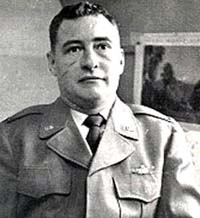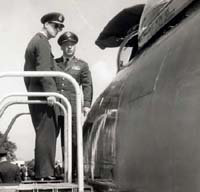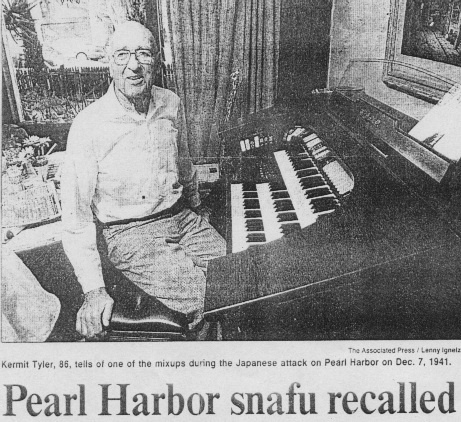(1953) The Furstenfeldbruck, Germany "Hot Guns" Era
by Colonel Robert Garrigan.
We've printed the RULES OF ENGAGEMENT exactly as provided by Bob Garrigan. Also, an excerpt from Stu Stabley's History of the 81st is attached as printed on page 81 of his authoritative and accurate portrayal of our history.
THE FURSTENFELDBRUCK DEPLOYMENT
At 1400 hours on Saturday, March 18, 1953 a 3AF operations order to deploy on temporary duty a squadron of Sabres to Furstenfeldbruck Air Base, Germany was received by the commander of the 81st. This was shortly after a Russion-built Mig-15 flown out of Czechoslovakia shot down a USAF F-84 being flown out of "Fursty". The mission was to identify unknown aircraft violatig the U.S. Occupation Zone of Germany. Guns were "hot".
As part of the 81st alert status a 24 hour telephone recall schedule was maintained. All fighter squadron members were required to be available by 'phone when the squadron was on recall status. On Saturday, March 18, 1953 the 92nd had the duty. Col. Garrigan, the Group Commander, got the word at 1400 hours and initiated the recall and Ops order to L/C Jim Carlyle, Commander of the 92nd Fighter-Interceptor Squadron stationed at Shepherds Grove. By nightfall all personnel, equipment and supplies were ready for departure.
On Sunday morning, the 19th of March, 1953 the Sabres were airborne. Following was a C-119 of the 60th Troop Carrier Wing and an 81st C-47. Two thirds of the airmen and all but two of the pilots in the squadron made the move.
Arriving in Germany, the pilots received one day of indoctrination and local familiarization flying. They took over the alert duties of the 36th Fighter-Bomber Group F-84 aircraft.
The alert duties required 12 Sabres on alert status from 1/2 hour before and 1/2 hour after sunset - four on the runway for immediate "scramble" and eight on five minute availability. The rest of the squadron was on a fifteen minute status and during the course of the day patrols were flown along the border under control of the ground controlled interceptor radar. The 92nd remained on station for three weeks and was relieved by L/C Ben Cassiday's 91st followed by the 78th commanded by L/C Arlie Blood, each for three weeks. Alert requirements in England continued.
During the nine weeks at Fursty the 81st Sabres made 36 strip alert scrambles to identify aircraft. In England during the same period only eleven were sirened into the air.
The move was a critical and exacting test of mobility. The short fuse during a weekend standby period tested the 81st. As usual the dedicated men excelled.
"Personal Property
of
Colonel Robert J. Garrigan"
Mission:
This unit is now under the operational control of the 12th Air Force, and our mission is to identify aircraft flying within the ten mile buffer zone or aircraft violating the U.S. Boundary.
We are not here to shoot down a MIG 15. The USAF has moved this unit here as a precautionary measure to protect our interest and to identify any barrier violation. This mission is most serious and will be regarded so during your stay here. Our Government and State Department can not afford any incident which involves a USAF aircraft that has violated the border, or any other incident involving the USSR or itís Satellites. Remember, w4e are not here to shoot down aircraft violating our boundary, but to identify them properly and if possible, direct them to land within our zone.
- FLIGHT RESTRICTIONS:
- No flight will proceed closer that thirty (30) miles to the U.S. occupied
Border unless under positive control of the radar station. No flight will proceed closer than thirty ( 30 ) miles to the U.S. occupied border unless under positive control of the radar station. No flight will proceed closer than ten ( 10 ) miles to the U.S. occupied boundary unless specifically directed by the control. If radio or radar contact is lost at any time, or a pilot recognizes a violation by dead reckoning, will immediately take up a westerly heading. Training flights will not be scheduled within thirty ( 30 ) miles of this border.
- No USAF aircraft will pursue a hostile aircraft across the border even
If a hostile act has been committed. Very serious results could occur,
Even with a situation of this type. For example, what if one our own aircraft was attacked within our zone, and then our pilots pressed their own attack and shot down a Mig within our zone, but the aircraft actually fell and hit the ground in Czechoslovakia. This type situation could easily occur, and its results might possibly involve the United States Government in a very serious problem.
- RULES OF ENGAGEMENT:
- Before I go any further, let me explain in my own words the Rules of Engagement. I might add that before explaining these rules, each pilot will be required to read and initial the TOP SECRET instructions on these rules before he is allowed to fly in this area. Briefly, the rule is this; you cannot fire on any aircraft unless you have been fired on first. If an aircraft has fired at you within our own zone, then you have the right to fire back this aircraft only within our own zone. If there is more than one aircraft within the hostile formation that has fired, then they will all be considered as hostile aircraft. Let me state again that none of these hostile aircraft will be chased across the border and fired on. We know that these rules are definitely not in our favor for longevity, but they are the rules that apply at this moment.
- Intercepts and Defector Flights:
- Now, after you know the rules, you can see how important the intercept will be for identification. If a situation arises where we should make an identification on a MIG 15 or MIGíS, any intercept which would normally be a pursuit curve and closing with our guns fixed on the MIG would certainly indicate to any fighter pilot a hostile pass. Therefore, be very very careful if this situation arises and try t9o fly parallel if possible without bringing your guns to bear directly on the MIG. There is always this situation to consider; he might be a defector and actually wanting to land in our zone. If you could possibly get him to land, it would be a fine catch for our Government. There has already been two cases of Czech aircraft landing in our zone within the last few weeks, so donít forget this possibility.
- Preparation Prior to Assuming Alert:
- Before any pilot is scheduled for alert, he will accomplish the following:
- Have had one indoctrination flight along the border to acquaint himself with check points.
- Have a map of the area which indicates the U.S. Border in RED.
- Understands the IFR and Scramble procedures. Fly a standard one beacon let-down and GCA.
- Read and Initialed the Rules of Engagement.
- Have been briefed on alternate diversion airfields and facilities.
- Briefed and a thorough understanding of minimum fuel requirements and distance from base.
- Understand VHF channelization.
- Briefed on he necessity of properly signing out when not on duty.
6. Group Policies:
- It will be a Group policy to fly with no less than two ( 2 ) aircraft
While operating within the thirty ( 30 ) mile buffer zone. A high Mach will carried while within this zone.
b. When aircraft abort on a scramble, the next two will be
scrambled to complete the mission, and the other return to base
to base.
c. While flying within the buffer zone, gun switches will be on
Camera with trigger pegged.
d. All local training flights will be conducted within the
Furstenfeldbruck local flying area.
REMEMBER, WE ARE HERE TO PREVENT A WAR, NOT TO START ONEÖ!
|

Click on above picture for full article (250kb)




